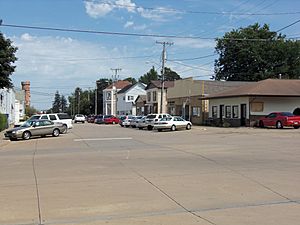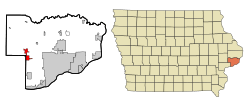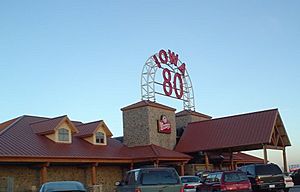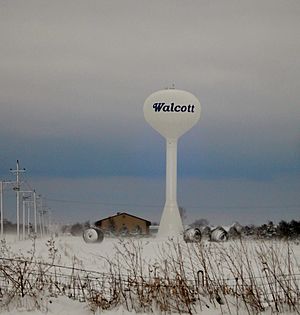Walcott, Iowa facts for kids
Quick facts for kids
Walcott, Iowa
|
|
|---|---|

Buildings along E. Bryant Street
|
|
| Motto(s):
"Heart & Hands Working Together"
|
|

Location of Walcott, Iowa
|
|
| Country | |
| State | |
| Counties | Scott, Muscatine |
| Area | |
| • City | 3.14 sq mi (8.12 km2) |
| • Land | 3.11 sq mi (8.06 km2) |
| • Water | 0.02 sq mi (0.06 km2) |
| Elevation | 732 ft (223 m) |
| Population
(2020)
|
|
| • City | 1,551 |
| • Density | 498.55/sq mi (192.47/km2) |
| • Metro | 382,630 (135th) |
| Time zone | UTC-6 (Central (CST)) |
| • Summer (DST) | UTC-5 (CDT) |
| ZIP code |
52773
|
| Area code(s) | 563 |
| FIPS code | 19-81705 |
| GNIS feature ID | 0462603 |
| Website | City of Walcott, Iowa |
Walcott is a city in Muscatine and Scott counties in the U.S. state of Iowa. The population was 1,551 at the time of the 2020 census. Walcott's interchange on Interstate 80 is home to an enormous complex of restaurants, motels and truck stops, including the Iowa 80 truck stop, which is the world's largest.
Most of Walcott is part of the Davenport–Moline–Rock Island, IA-IL Metropolitan Statistical Area, but the Muscatine County portion of the city is considered part of the Muscatine Micropolitan Statistical Area.
History
Walcott was incorporated on July 10, 1894.
The City of Walcott was originally platted in 1854. The first passenger train route west of the Mississippi River started in 1855 and helped Walcott grow. William Walcott, who was a director of Chicago and Rock Island Railroad, donated $500 in 1855 for the construction of a school building, with the stipulation that the fledgling town along the railroad tracks near Davenport be named after him.
Long before Walcott was even a vision to William Walcott, it was a great expanse of open prairie inhabited by the Kaskaskia Indians. The Kaskaskias were later driven out of the Quad Cities area by the renegade Mesquaki tribe. This tribe, a splinter of the Canadian Iorquois, was America's largest Indian nation.
In 1857, much of the Walcott land was sold for as low as 75 cents an acre, enabling many German and Scotch-Irish immigrants to settle in the area. Many of the Scotch-Irish worked for the railroad builders and settled on the farmland south and west of the town. While they contributed much to the early development of Walcott, around 1871 they began to move farther west. Most of the German settlers were from Schleswig-Holstein, northern Germany, and some came from eastern and southern Germany. By 1910, nearly 90 percent of the farmland in Scott County was owned by German immigrants or their descendents.
A petition for incorporation was signed and presented to Judge C.M. Waterman of the District Court at Davenport on June 5, 1894. At that time, the total population was 354. The election was held on July 7, 1894, and of the 81 votes cast, 54 were in favor of the incorporation. The result of the election was approved and filed by the District Court on July 14, 1894.
Long before most small towns thought of supplying their citizens with water, Walcott had plans for an efficient and adequate water system. Walcott was the first rural Scott County community to build a water system and water tower. The installation was completed in 1897, and provided the citizens of Walcott with inexpensive water service, good drinking water, and improved fire protection. In 1914, the first sewage disposal system was built. Lagoons for the sanitation system were installed in the late 1960s and three cells were added to the lagoon system in 1975.
As early as 1897, the people of Walcott banded together to provide an organized way of fighting the terror and destructiveness of fire. In those early days, the department consisted of a small number of volunteer firemen and two hand-pulled hose carts. In 1931, the town built a fire station and city hall. Today, that same building houses the Fire Department and City Hall.
The Walcott Savings Bank was organized in 1894 with a capital stock of $30,000. On April 1, 1904, the Farmers Savings Bank began business with at capital stock of $25,000. In 1911, Walcott was declared the richest town in the USA in consideration of the bank deposits for its population of 300, according to Dunn & Co. in the Bankers' Journal of New York. During the depression year of 1931, the two banks were consolidated and Walcott Trust and Savings Bank was formed.
The original town was expanded in 1962 to include Highway 6. Additional ground was annexed in 1973 to include the Interstate 80 interchange area and the French and Hecht Building, which currently houses FirstCo Inc. In the early 1990s, quadrants adjacent to and near the Interstate 80 interchanged were also annexed in. The annexation of the area near Interstate 80 has increased the area's valuation significantly. Many businesses, including the world's largest truck stop, Iowa 80 Truck Stop, is located within the city limits.
In 1997, Walcott joined in a sister city partnership with Bredenbek, Germany. Bredenbek is located in northern Germany.
Geography
Walcott is located at 41°35′25″N 90°46′23″W / 41.59028°N 90.77306°W (41.590363, -90.772991).
According to the United States Census Bureau, the city has a total area of 3.49 square miles (9.04 km2), of which, 3.47 square miles (8.99 km2) is land and 0.02 square miles (0.05 km2) is water.
Demographics
| Historical populations | ||
|---|---|---|
| Year | Pop. | ±% |
| 1900 | 362 | — |
| 1910 | 416 | +14.9% |
| 1920 | 384 | −7.7% |
| 1930 | 398 | +3.6% |
| 1940 | 440 | +10.6% |
| 1950 | 480 | +9.1% |
| 1960 | 664 | +38.3% |
| 1970 | 989 | +48.9% |
| 1980 | 1,425 | +44.1% |
| 1990 | 1,356 | −4.8% |
| 2000 | 1,528 | +12.7% |
| 2010 | 1,629 | +6.6% |
| 2020 | 1,551 | −4.8% |
| Source: and Iowa Data Center Source: |
||
2010 census
As of the census of 2010, there were 1,629 people, 694 households, and 456 families living in the city. The population density was 469.5 inhabitants per square mile (181.3/km2). There were 806 housing units at an average density of 232.3 per square mile (89.7/km2). The racial makeup of the city was 97.5% White, 0.2% African American, 0.2% Native American, 0.3% Asian, 0.5% from other races, and 1.2% from two or more races. Hispanic or Latino of any race were 2.5% of the population.
There were 694 households, of which 31.7% had children under the age of 18 living with them, 50.3% were married couples living together, 10.8% had a female householder with no husband present, 4.6% had a male householder with no wife present, and 34.3% were non-families. 29.1% of all households were made up of individuals, and 13.2% had someone living alone who was 65 years of age or older. The average household size was 2.35 and the average family size was 2.86.
The median age in the city was 40.3 years. 24.9% of residents were under the age of 18; 7% were between the ages of 18 and 24; 25.6% were from 25 to 44; 26.7% were from 45 to 64; and 15.8% were 65 years of age or older. The gender makeup of the city was 49.5% male and 50.5% female.
Town twinning
 Bredenbek in Germany
Bredenbek in Germany
Education
Davenport Community School District serves almost all of Walcott. Zoned schools include Walcott Elementary School, Walcott Intermediate School, and Davenport West High School.
See also
 In Spanish: Walcott (Iowa) para niños
In Spanish: Walcott (Iowa) para niños



